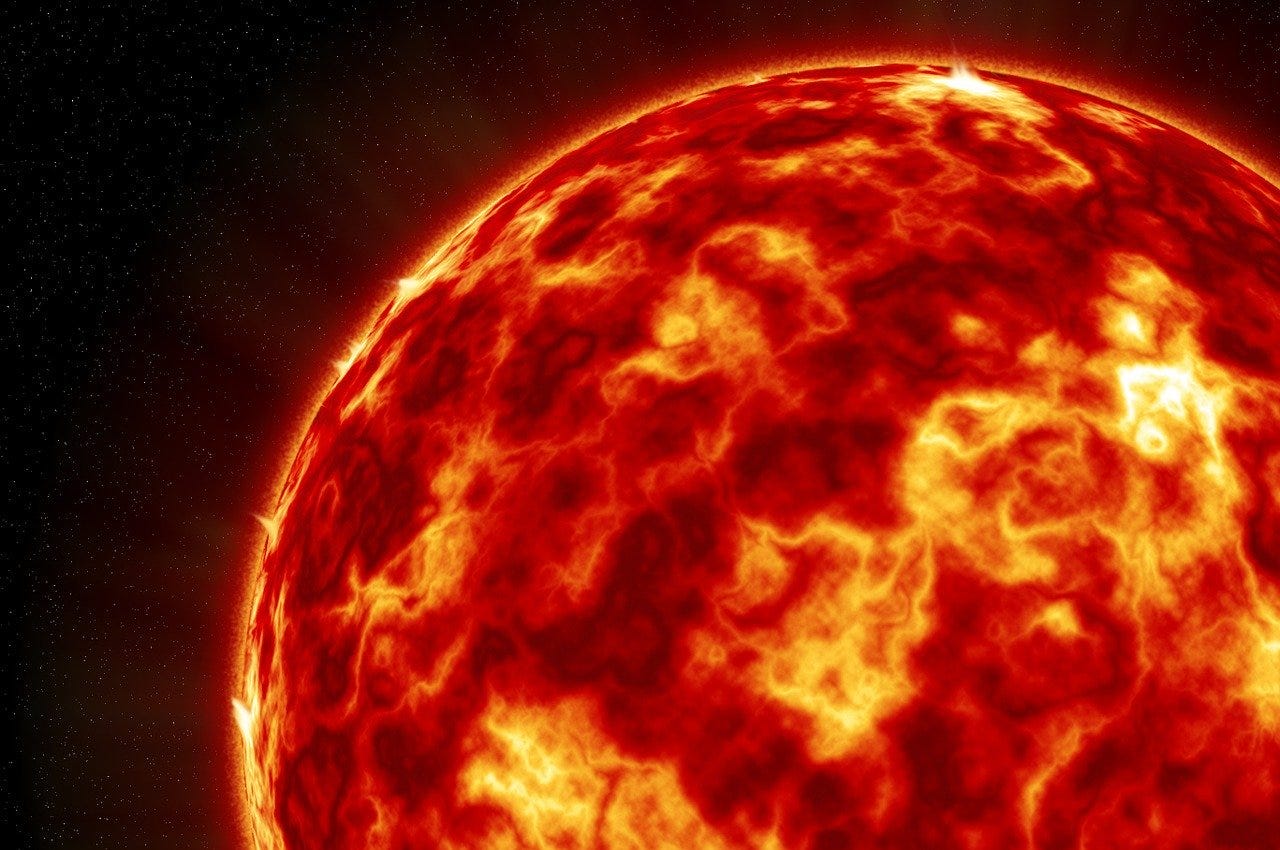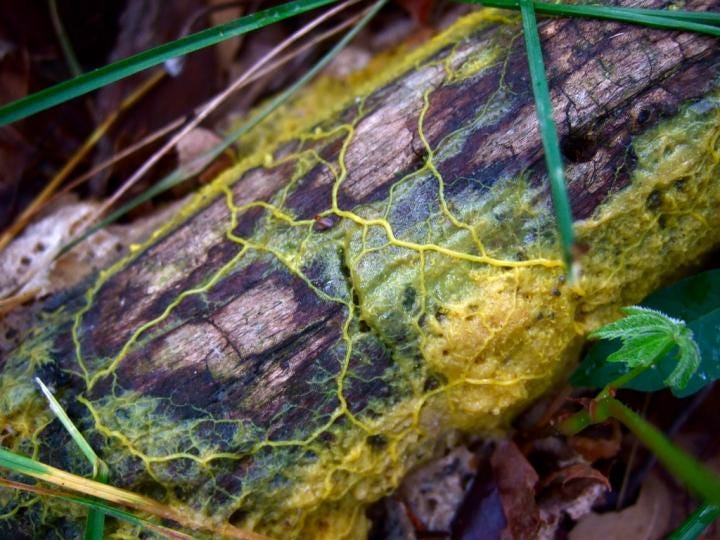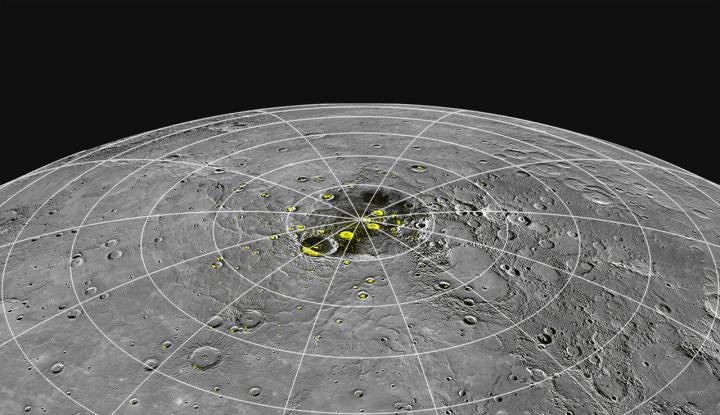The Cosmic Companion March 17, 2020
Interviewing Dr. Emily Levesque about Betelgeuse, plus stellar turbulence, a planet with iron rain, modeling galaxies using slime mold, and how ice forms on Mercury.
Hello everyone!
My apologies getting this newsletter out a day late. Things have been crazy around here, and we send everyone our best wishes for the weeks and months ahead. We expect the flow of astronomy news to go down as universities and research facilities close. We will do our best to continue to provide interesting news, interviews, and other features about astronomy and space exploration (although we may change things up next week to regroup - I’ll still try to get the video and podcast out).
The podcast version of this week’s show features a full interview Dr. Emily Levesque of the University of Washington. She is one of the lead researchers on the study examining the possibility that a massive cloud of dust surrounding Betelgeuse may be responsible for dimming seen around that star at the end of 2019.
On our next show, we interview Alan Adler, inventor of the Aerobie flying ring, and the Aeropress coffee maker about the science of flying toys and making coffee!
Also in this week's edition of The Cosmic Companion, we look at new findings concerning the physics of stars, and we look in on a newly-discovered exoplanet where it rains iron. Next, we will examine a new method of learning about massive ribbons of galaxies by examining humble slime molds. Finally, a group of researchers believe they may have found a method by which the intense heat of Mercury could help form ice on the innermost planet in the Solar System.
Remember that the Cosmic Companion also offers a premium newsletter, featuring weekly exclusive videos, advance viewings of Max on Mars (and other comics). Just $5 a month, or $50 a year! Sign up at: https://thecosmiccompanion.substack.com.
Or, you can buy me a cup of coffee for my work!
Let’s take off!
The Week in Space
Stellar Turbulence Shapes Activity of Stars
Stellar turbulence plays a significant role in the production of starlight, a new study from the Max Planck Institute reveals.
By James Maynard

What gives rise to activity on the Sun and other stars? A new pair of studies seeks the answer. Image credit: LPICGR/Pixabay
Stars shine as a result of fusion reactions at their cores, transforming one element into another, heavier, type of atom. Energy from these reactions works its way outward, through various layers of the Sun, each with its own distinctive characteristics.
Outside the core lies the radiation zone, through which energy travels in the form of high-energy electromagnetic waves. As the energy cools, the main method of transport becomes plasma flows, forming the next layer out from the center of the Sun — the convection zone. Here, heated plasma (the fifth state of matter) rises, cools, then sinks back again, creating conditions similar to boiling water.
Read more: http://bit.ly/Stellar-Turbulence-Activity-Stars
Iron Rain Bombards a Distant Exoplanet
The distant world of WASP-76b possesses a violent environment where one side of the planet is perpetually scorched by its star whilst the other is bombarded with iron rain.
By Rob Lea

Geneva cartoonist Frederik Peeters takes a whimsical look at a hellish landscape. Image credit: Frederik Peeters
The more exoplanets astronomers discover the more they find that the universe is filled with extraordinary and unusual worlds. A prime example would be WASP-76b, which an international team of astronomers led by researchers from the University of Geneva (UNIGE) have discovered possesses one-side that is brutally bombarded by iron-rains, whilst the other is mercilessly roasted by radiation from the planet’s star.
The giant exoplanet — part of a new category of bodies called ‘ultra-hot Jupiters’ — has a scorching hot ‘dayside’ where temperatures can reach in excess of 2,40⁰⁰C, and a ‘nightside’ which is cooler by at least 1,00⁰⁰C. This means that on the former side, metals are vapourised by the ultra-hot temperatures and then carried across the planet by powerful winds. Once reaching the cooler side, the resulting iron vapour condenses into droplets of iron which rain down onto the surface of the planet.
Read more: http://bit.ly/Iron-Rain-Exoplanet
Modeling the Universe with Slime Mold
A new study examining the growth of slime mold could help astronomers understand the development of galaxies in the cosmic web.
By James Maynard

The slime mold Physarum polycephalum produces tendrils resembling the cosmic ribbons that connect galaxies together. Image credit: Frankenstoen/CC BY
Slime mold has a surprising resemblance to groups of galaxies, a new study reveals. By studying the way these primitive lifeforms grow, researchers hope to better understand how and why galaxies form into massive strands that stretch across the Cosmos, forming the largest structures in the Universe.
The single-celled Physarum polycephalum builds complex networks of filaments in its search for food. In doing so, this simple lifeform creates highly-efficient pathways connecting different locations. Like this variety of slime mold, galaxies also formed within thin ribbons millions of light years long, connected by deposits of gasses. The networks completed by galaxies and the primitive organisms have more than a passing resemblance to each other.
On March 31, I will interview Dr. Joe Burchett of The University of California, Santa Cruz, lead researcher on this study, on the Astronomy News with the Cosmic Companion podcast.
Read more: http://bit.ly/Modeling-Universe-Slime-Mold
Ice on Mercury may Form at Scorching Temperatures
Astronomers find evidence of the most powerful explosion ever seen in the history of the Universe. What do we know about this mammoth eruption?
By James Maynard

The Messenger space craft confirmed ice deposits in the polar regions of Mercury. Image credit: NASA/Messenger
The scorching surface of Mercury, where temperatures can reach 400 degrees Celsius (750 Fahrenheit), may seem to be the last place astronomers might find ice. However, this enormous heat could play a significant role in the formation of ice on Mercury, a new study reveals.
Many astronomers believe that most of the water on the Mercury was likely delivered to the surface of that diminutive world by asteroids. Within the polar craters of Mercury, ice could stay frozen in eternal darkness.
“Water ice on the surface of Mercury is exposed directly to vacuum, and will rapidly sublime [turn directly from solid to vapor] and escape into space unless it is kept cold at all times. This implies that the ice can never be exposed to direct sunlight. The only locations on the surface of Mercury where this is possible would seem to be near the poles, where the floors of some craters might be deep enough to afford permanent shading,” David Williams of the NASA Goddard Space Flight Center explained in 2012.
Read more: http://bit.ly/Ice-Mercury-Temperatures
Astronomy News with The Cosmic Companion
Here’s our video episode for the week ending March 17, 2020
Our podcast version of this episode can be found here on Substack, or on any major podcast provider.
Cosmic Comics
Max on Mars
In One Small Step for a Cat, Max figures out how he can go outside to explore the Red Planet! What does this mean for Nemo?

Read more adventures of this interplanetary kitty at www.MaxOnMarsComic.com and follow him on Instagram @MaxOnMarsComic!
Read more stories at www.thecosmiccompanion.com
Follow the podcast, video series, AI show and more at www.thecosmiccompanion.net

Coming soon: The First Woman on the Moon: The Past and Future History of Women in Space by James Maynard
Thanks for reading!
You can listen to our new podcast, Astronomy News with The Cosmic Companion, available on all major podcast distributors, including iTunes, Spotify, and TuneIn! Or, tune in at: https://thecosmiccompanion.substack.com. And, don’t forget to add Astronomy News with The Cosmic Companion to your flash briefings on Amazon Alexa!
If you want to keep up with the latest updates and news about astronomy and space exploration, visit www.thecosmiccompanion.com, for information about our weekly video show, podcast, comics, mailing list, and more, visit our new website at: www.thecosmiccompanion.net.
Remember - VIP subscribers receive this newsletter, plus a second weekly newsletter with sneak previews of each video episode of Astronomy News with The Cosmic Companion, an astronomy comic of the week, rare space photos, and more! Plans start at just $5!
Do you know someone else who would love this newsletter? Please share! Invest in knowledge with a premium subscription for yourself or a loved one today (including advance viewings of my weekly video show)! Or, I’d love it if you could buy me a cup of coffee - I LOVE coffee!
Thanks for everything and I will see (hopefully) you next week!
Astronomy - Don’t Leave Home Without It!
- James


